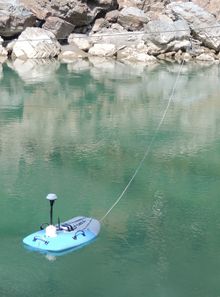Difference between revisions of "Discharge - ADCP (SonTek RiverSurveyor)"
Jump to navigation
Jump to search
| Line 39: | Line 39: | ||
* Stratification of temperature and salinity affects the depth measurement. This can be corrected for when a CastAway CTS sensor is used. Import of data otherwise acquired is not supported. | * Stratification of temperature and salinity affects the depth measurement. This can be corrected for when a CastAway CTS sensor is used. Import of data otherwise acquired is not supported. | ||
* The built-in temperature sensor shows strong thermal inertia, ie reacts slowly. In our test, an initial temperature difference of only 4 K (10°C to 6°C) took ~1 hour to equilibrate. The endpoint temperature was still 2 K above conventional measurements. | * The built-in temperature sensor shows strong thermal inertia, ie reacts slowly. In our test, an initial temperature difference of only 4 K (10°C to 6°C) took ~1 hour to equilibrate. The endpoint temperature was still 2 K above conventional measurements. | ||
| + | * When the sensor is not properly connected to the PCA, the latter appears fully operational, but does not connect via radio. | ||
==Problems/Questions:== | ==Problems/Questions:== | ||
Revision as of 14:18, 5 January 2016
Parameter to be measured:
Discharge, flow velocity, depth
Method:
Acoustic Doppler Current Profiling
Equipment:
- sensor (M9)
- processing unit (data processing, storage, GPS receiver, communication)
- GPS antenna
- platform (raft)
Advantages:
- high resolution velocity profile of river transect (up to 128 cells)
- dual frequency sensor covers wide range of depths (0.3 - 40 m)
- position can be estimated via both bottom tracking and GPS
- intuitive software for both PC and Windows Mobile
- measurement continues even when connection is lost
- configurable options (communication: BT/radio, GPS: GPS/GNSS, platform: low /high velocity/remote controled)
Disadvantages:
- platform is quite bulky
- price
What to watch out for:
- transversal speed must be lower than flow velocity
- deeply incised riverbeds and vegetation may strongly impair GPS reception
- The product basic GPS-setting is advertised as "dGPS", but is merely ordinary SBAS-corrected GPS. True dGPS-solutions (base - rover) do exist, but post processing is not supported. Other GNSS-receivers may be customized with extra hardware.
- Stratification of temperature and salinity affects the depth measurement. This can be corrected for when a CastAway CTS sensor is used. Import of data otherwise acquired is not supported.
- The built-in temperature sensor shows strong thermal inertia, ie reacts slowly. In our test, an initial temperature difference of only 4 K (10°C to 6°C) took ~1 hour to equilibrate. The endpoint temperature was still 2 K above conventional measurements.
- When the sensor is not properly connected to the PCA, the latter appears fully operational, but does not connect via radio.
Problems/Questions:
- How does sediment concentration affect the measurements?
Price:
35000 € with basic GPS option and Hydroboard (2013, Germany)
Links
Projects that used the above equipment:
Other related web sites:


